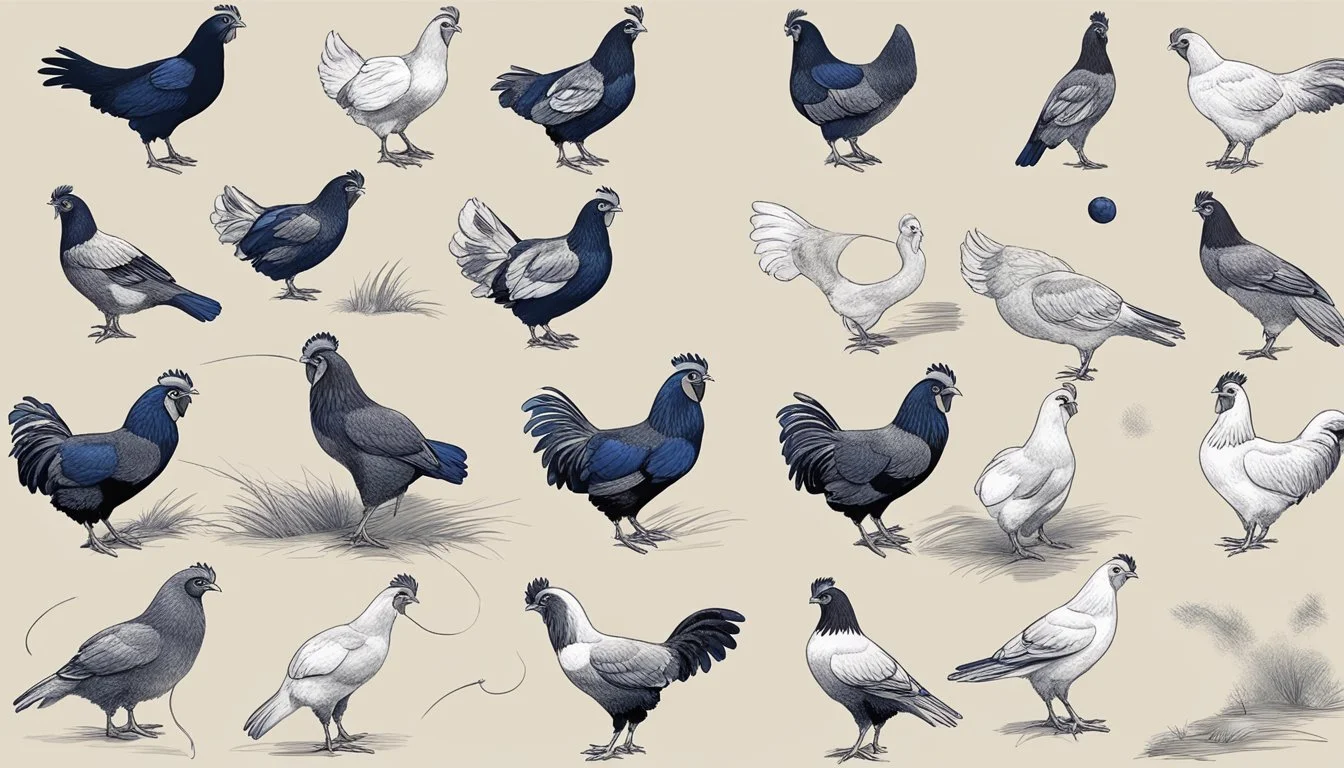The Ultimate Guide to Poultry Leg Rings
Expert Tips for Bird Identification and Management
Poultry leg rings, also known as leg bands, serve as the cornerstone of effective flock management, enabling backyard poultry enthusiasts and homestead owners to identify and keep track of their feathered residents with ease. These bands, which wrap snugly around a chicken's leg, are employed not only to distinguish individual birds by identification numbers or colors but also to facilitate record-keeping for breeding, laying performance, and health monitoring.
The application of leg rings is a straightforward procedure that requires minimal equipment and can be performed at various stages of a bird's life, typically starting as early as two weeks old. It is paramount, however, to ensure that these identifiers are fitted correctly—neither too tight to impede circulation and cause injury nor too loose to fall off. This balancing act ensures the chicken's safety and comfort while providing a reliable method for owners to maintain the integrity of their flock data.
Understanding the types and purposes of leg rings is essential for any poultry keeper. They not only prove ownership and help manage genetic lines in breeding programs but also simplify the process during poultry shows and sales. With a range of materials, sizes, and types available, the selection of a suitable leg ring aligns with the specific needs and preferences of the birds and their caretakers.
Basics of Poultry Leg Rings
Poultry leg rings are essential for managing a flock, allowing for easy identification and tracking of individual birds. This section will explore their purpose, the various types available, and how to select the appropriate size for different poultry.
Purpose of Leg Rings
Leg rings serve as a simple yet effective way to identify poultry within a flock. They can prove ownership, facilitate accurate breeding records, and assist in disease control by tracking the movements and lineage of individual birds. Breeders and show keepers utilize leg rings to distinguish between similar-looking fowl and maintain meticulous records.
Types of Poultry Leg Rings
There are several types of leg rings available for poultry:
Plastic Snap Rings: These rings come in a range of colors and sizes and are clipped around the bird's leg.
Spiral Rings: Usually made of plastic or metal, spiral rings are twisted onto the leg and often used for temporary identification.
Adjustable Snap Rings: These can be resized as the bird grows and are a more permanent option.
Numbered Rings: Employed for precise record-keeping, numbered rings have individual IDs for each bird.
Selecting the Right Size
Selecting the correct size of poultry leg ring is crucial to ensure the well-being of the bird:
Measure Leg Diameter: Use a caliper or similar tool to measure the diameter of the bird's leg to find the appropriate ring size.
Consult Size Charts: Refer to official size charts from poultry organizations for guidance. As an example, a Lincolnshire Buff may require a size G22, while a Malay may need an F20 or E18, but sizes may vary based on individual circumstances.
Check for Free Movement: Rings should move freely on the leg but not slip over the foot or be too tight to cut off circulation.
Using Leg Rings for Identification
Identification using poultry leg rings is an efficient and widely accepted method for tracking and managing individual birds within a flock. This system allows for quick visual identification, which is essential for breeding, showing, health management, and ownership verification.
Color Coding System
Using a color coding system is a straightforward approach to organize individuals or groups within a flock. Breeders can assign specific colors to different ages, breeds, or to indicate vaccination status. For example, red bands might denote layers, while blue bands can be assigned to meat breeds.
Numbering and Lettering
Apart from colors, poultry leg rings can have numbers or letters printed on them. Each bird is given a unique identifier that can correspond with records that contain details about the bird’s age, breed, and lineage. This specific information assists in preventing mix-ups and assisting with selective breeding practices.
Record Keeping Strategies
Maintaining accurate records is critical when using leg rings for identification. Breeders should create a record-keeping system that includes a spreadsheet or database with corresponding leg ring information. They should regularly update the database with hatch dates, health information, and other relevant details to ensure traceability and proper management of the flock.
Application and Removal Techniques
Applying and removing leg rings from poultry requires precise methods to ensure the welfare of the birds and accuracy of identification.
How to Apply Leg Rings
To apply leg rings, one must first securely catch the chicken without causing it stress. Once calmly restrained, select the correct size ring to avoid discomfort or loss. For chicks around two weeks old, closed bands are suitable and are applied by sliding them over the chick's toes and up to the leg, often requiring pliers to close the slit in the band. For fully grown poultry, adjustable open bands are more appropriate; they can simply clip around the leg without the need for tools.
How to Remove Leg Rings Safely
Removing a leg ring necessitates caution to prevent injury. Inspect the leg and the band for any signs of swelling or feather entrapment. In the case of closed bands, gently expand the slit using pliers, ensuring not to pinch the bird’s leg. For open bands, carefully unclip the band, being mindful of the bird’s comfort throughout the process. Should the leg ring appear stuck, consult a veterinarian to avoid harming the bird.
Health and Safety Considerations
When using leg rings for poultry, it's crucial to monitor the birds for any signs of injury and to maintain proper hygiene of the leg rings to prevent potential health issues.
Monitoring for Injuries
Individuals must regularly inspect the legs of chickens fitted with leg rings to ensure that no abrasions or constrictions are occurring. Early detection is vital; signs such as limping, swelling, or a reluctance to move can indicate that the leg ring is too tight or causing discomfort.
Observations should include:
Checking for cuts or swellings around the leg ring area
Ensuring rings are not too tight, impeding circulation
Watching the bird’s gait for signs of discomfort
Maintaining Leg Ring Hygiene
The cleanliness of leg rings is imperative to prevent infections or disease spread. Poultry keepers should clean leg bands routinely and check for any buildup of dirt or debris that can harbor bacteria.
Hygiene practices include:
Washing leg rings with a safe disinfectant during routine checks
Replacing leg rings that are damaged or excessively worn
Making sure that the leg rings are dry and free of irritants after cleaning
Leg Rings for Breeding Management
Leg rings provide a reliable system for poultry breeders to manage their breeding programs effectively. They facilitate the tracking of genetic lines and the organization of breeding pairs for desirable traits.
Tracking Bloodlines
Using leg rings is an essential tool in monitoring and preserving the lineage of poultry on a homestead. Each leg ring is individually numbered and often includes the year of birth, allowing breeders to trace the ancestry of each bird. This is especially important for maintaining pure breeds or developing new lines. By documenting the numbers associated with specific traits or bloodlines, breeders can make informed decisions when selecting birds for mating.
Example of Bloodline Tracking:
Ring Number: B11 - Heritage breed, known for hardiness and egg production
Ring Number: E18 - Hybrid line, favorable for meat yield
Managing Breeding Pairs
Leg rings are instrumental in organizing breeding pairs. They suffice for breeders to accurately match males and females according to genetic traits or desired outcomes. By assigning specific ring identifiers to selected birds, breeders ensure that the mating process is controlled and prevents inbreeding. It is vital for rings to be checked regularly to ensure they move freely and to adjust sizing if necessary, especially to keep rings above the spur in males to avoid injuries.
Breeding Pair Management Strategies:
Use contrasting ring colors for each sex to differentiate at a glance.
Maintain records of which ring numbers are paired together to assess breeding success and make future pairing decisions.
Legislation and Ethics
In the realm of poultry keeping, understanding and adhering to relevant laws is essential, as is considering the welfare of the animals when using identification methods such as leg rings.
Regulatory Compliance
Legislation concerning the use of poultry leg rings varies by country and region. Keepers must acquaint themselves with specific regulations that govern the identification of birds. In the European Union, for instance, regulations might mandate standardized rings for certain species. In the United States, the USDA’s National Poultry Improvement Plan (NPIP) provides guidelines for the identification of poultry involved in interstate commerce, and requirements might include the use of clean and sized-appropriate leg bands:
Size-appropriate: Leg bands must be well-fitted, ensuring no harm comes to the bird.
Cleanliness: Bands should be free of pathogens to prevent spread of disease.
Ethical Considerations
When applying leg bands for identification, poultry keepers carry the responsibility to ensure that the birds' welfare is the top priority. Bands should be neither too tight to impair circulation nor too loose to risk entanglement. Ethical use implies:
Animal welfare: Prioritizing the comfort and safety of the birds during application and wear.
Monitoring: Regular checks to ensure bands remain safely in place without causing distress or injury to the poultry.
It’s crucial for poultry keepers to balance the need for reliable identification with the imperative to treat animals humanely.
Advanced Tracking Systems
Innovations in poultry farming have led to sophisticated methods for tracking and managing birds. Producers now have access to advanced systems that offer precise identification and real-time location tracking.
Electronic Identification
Electronic identification systems employ technology to uniquely identify each bird. These tools enhance the efficiency of farm management by providing quick and accurate data acquisition on individual birds. Electronic leg rings, also known as E-rings, are a common form of electronic identification. E-rings can store a wealth of information, including age, vaccination records, and breeding data. They are scanned using specialized equipment, ensuring quick access to a bird's history and health records.
GPS and RFID Usage
The use of Global Positioning System (GPS) technology and Radio-Frequency Identification (RFID) tags has revolutionized poultry tracking. These technologies contribute to a multitude of applications, including:
Behavioral monitoring: Tracking movement patterns and activities.
Health management: Observing signs of distress or illness.
Security: Protecting valuable breeds from theft.
GPS-enabled devices can provide real-time geographic locations, while RFID tags, typically attached to leg rings or wing bands, allow for proximity-based identification. These systems offer substantial benefits in terms of labor savings and improved accuracy over manual tracking methods.
Troubleshooting Common Issues
When utilizing poultry leg rings for identifying and tracking chickens, breeders may occasionally face issues such as rings getting lost or not fitting properly. It's critical to address these problems promptly to maintain accurate records and ensure the welfare of the birds.
Lost Leg Rings
Causes:
Wear and Tear: Daily activities can wear down a leg ring, leading to breakage.
Incorrect Application: If not secured correctly, a leg ring can come loose and fall off.
Solutions:
Regular Checks: Inspect leg rings during routine health checks to assess their condition.
Quality Materials: Use durable materials for leg bands to reduce the chance of breakage.
Secure Fastening: Ensure leg rings are fastened securely without impeding the chicken's movement or causing discomfort.
Misfitting Rings
Signs of a Misfit:
Too Tight: The chicken shows signs of discomfort, restricted movement, or swelling above or below the ring.
Too Loose: The ring slides freely or can spin around the leg easily.
Adjustments:
Proper Sizing: Measure the chicken's leg to choose an appropriate ring size; this will prevent tightness and allow for growth.
Timely Replacements: Adjust or replace leg rings as chickens grow to prevent the rings from becoming too tight.
By using this guide to identify and swiftly rectify these common issues, poultry keepers can ensure their flocks remain properly identified and healthy.
Resource and Supply List
To effectively use poultry leg rings for identifying and tracking your poultry, certain resources and supplies are essential. The following list outlines the items needed to properly implement a leg band identification system:
Poultry Leg Rings: They come in various sizes and colors, and may feature numbers or letters for easy identification. Ensure the leg rings are appropriate for the bird species and age.
Leg Ring Applicator: This tool aids in the safe application of leg rings without harming the poultry.
Record-Keeping Notebook or Software: Critical for recording the corresponding ring numbers and the details of each individual bird.
Measuring Gauge: To measure the birds’ legs to ensure proper fitting of the leg rings.
Poultry Leg Ring Options:
Spiral Leg Rings: Easy to apply, no tools needed. Reusable and comes in colors. Used for small-sized birds.
Clip Leg Bands: Require an applicator, secure, and often numbered. Used for larger poultry.
Adjustable Leg Bands: Can be resized, making them suitable for growing poultry. Used for juvenile birds.
When purchasing leg rings, it is advisable to source them from reputable suppliers to guarantee quality. Here are a few items one might find:
Poultry ID Bands: Available for purchase at farm supply stores like Tractor Supply Co. or online.><








